First things first.
Too often fundraisers, board members, and nonprofit leaders spend way too much time thinking and talking about their organization’s or their employee’s process for raising major gifts (including legacy gifts).
Usually it looks something like this:

It’s not a bad idea to spend some time thinking about internal operations. But focusing too much on what you and your staff will do leaves something very important out of the equation: THE DONOR and what they will do. Their consideration process is more important than your operational/tactical process. Therefore, you need to spend more time focusing on them and that.
And besides, your donors don’t care very much about what you want. And they don’t care about your internal, operational processes. What they care about is themselves! They care about their needs, their interests, their desires and their consideration timeline. They have a process all their own. And, if you rush them through it, they’ll feel pressured and recoil. Or, if you fail to even recognize that their consideration process exists, you’ll end up trying to ‘move’ them forward in your operational process rather than trying to help them facilitate their own movement through their consideration process.
Trying to move people forward is like trying to get your boss to make a big change at your organization. If you try to move her to make the decision you want, you will probably make her feel uncomfortable, and that could lead to delays, rejection of the change entirely, or worse, your ouster. Alternatively, facilitating her movement through the consideration process instead — so she feels like she is discovering on her own that it’s a good idea to make the change — works almost every time.
The same methodology works when it comes to how you should help your major (including legacy-minded) donors make their decisions. All of us know this instinctively. We know that people make decisions on their own timeline and when they feel like it was their idea to go forward. But, for some strange reason, fundraisers tend to fall back on traditional, transactional, organization-centric, operation-oriented orthodoxies. And, too often these tactics are championed by people who don’t ever actually meet with donors face-to-face (such as writers of blogs, webinar presenters, conference speakers, and other people usually working for CRM or wealth screening companies).
These days, dependence on these conventions won’t work. So today, I’ll explain what does work below. I’ll simplify a ton of behavioral science for you in this blog post. Then you’ll be able to help your colleagues, leaders and board members understand why you can’t just email or direct mail a prospective major donor and get the meeting or the gift right away.
There are essentially two types of consideration processes for giving.
When people think about giving up their hard-earned money, they either make the decision to move forward quickly or slowly. Usually the timeline correlates with the amount of money they are considering giving up since that alters a ‘convenience quotient’ (so to speak).
In other words, as the value ($) of the gift increases and as it becomes less convenient to make the gift, the deliberation timeline lengthens. For instance, larger gifts that involve less ‘convenient’ giving options (requiring financial or estate planning) add to the amount of deliberation the donor will find necessary, thereby slowing down the decision-making process. Similarly, as the value of the gift decreases and giving becomes more convenient (with cash or a credit card online for instance), the donor is likely to make the decision to give much more quickly.
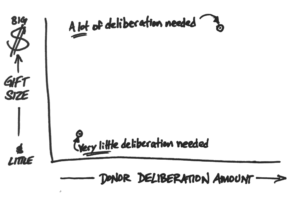
As a result, fundraisers will encounter basically two types of donor consideration processes:
- Impulse-oriented decisions: These are very common, transactional, low-dollar decisions that only require a few seconds or minutes to consider and complete. Trust is important but not crucial and personal relationships are not necessarily required at all.
- Highly-considered decisions: These are much more significant, tremendously impactful high-dollar decisions. Therefore, they require much more deliberation as well as deep, trusting relationships. They often require weeks, months, years, or even decades of deliberation before a decision is made and action is taken.
Where’s your focus?
Most fundraisers and organizations seeking donations spend most of their fundraising budget dollars on inspiring impulse-oriented, low-dollar decisions.
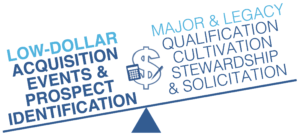
I figure the impetus for this is that most fundraisers are not wealthy. So they usually don’t have much experience with highly-considered, high-dollar decisions — especially philanthropic giving decisions. It’s only when they buy cars, houses, or plan big vacations that they ever need to involve themselves with highly-deliberative purchase processes.
I believe this must be one of the main reasons why so many fundraisers feel so comfortable disseminating communications that inspire mostly impulse-oriented, low-dollar decisions using direct response methods (including direct mail, telemarketing and email). The transactional nature of those kinds of efforts is more likely to align with how they give when they support causes. As a result, the sector tends to spend most of its fundraising dollars in a ‘comfortable’ arena — focused on inspiring low-dollar, transactional decisions instead of on inspiring high-dollar, more deliberate decisions (even though most of the money nonprofits collect comes from relatively few major donors making impactful gifts thanks to a more deliberative process).
Another thing to note about the current paradigm for many is that learning how to associate with very wealthy people and provide them with communications that line-up with their more deliberate consideration process is quite challenging. For many (especially marketing staff), it’s easier to simply hit the ‘send’ button on an email blast or sign another purchase order allowing a vendor to spray and pray (with junk mail and spam) tons of low-dollar donors than it is to build a seriously strategic communications infrastructure that aligns with a major and legacy gift donor’s consideration timeline.
What follows is predictable. Most of the marketers in-house or the vendors (especially direct response agencies seeking to provide services that are attractive to fundraisers) adjust their pitches and proposals with a concentration on low-dollar, transaction-oriented fundraising efforts that generate lots of small donations.
Additionally, most organizations simply don’t have enough patience. I get it. They need money now. However, the way they go about getting it isn’t in alignment with major donor needs.
Too often, they pummel their well-meaning supporters with solicitations to keep the impulse-oriented, transactional, small gifts flowing steadily. Or, they try out new marketing ‘shiny objects.’ These days such tactics usually promise to harness the power of artificial intelligence (including machine learning) to improve results. The AI suppliers promote their wiz-bang tech because they know what appeals to fundraisers. However, both nonprofits and their supporters would be much better off in the long-run if organizations would become more patient and focus more of their attention on strategies that provide value to the people who can make exponentially more impact.
Unfortunately, the ‘shiny objects’ might even work… to a certain degree. I say ‘unfortunately’ because too many in our field get addicted to transactional giving. And, although the ‘shiny objects’ might increase giving rates and dollar amounts in the near term, they are still transactional and transactional giving won’t ever move the needle all that much. Your organization would benefit much more from transformational gifts, wouldn’t it?
For transformational gifts patience is essential. The well-meaning, philanthropic-minded people supporting your mission through major gifts simply don’t want to make highly-considered decisions impulsively and they don’t want impersonal, transactional relationships. Rather, they want to find meaning in their lives. They want to give back. They want to realize the best versions of themselves. And they want to make impact. So they take their time as they deliberate and seek out trustworthy facilitators (fundraisers). It’s essential for them to do so as they work toward fulfilling their needs for self-actualization (as seen at the top of Maslow’s Hierarchy Of Needs).
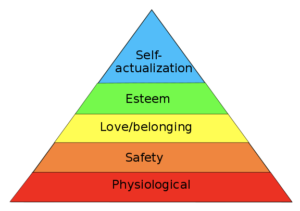
That’s why by attempting to make them move their decision-making process faster (on your terms, not theirs), you’ll only end up with low-dollar ‘go-away gifts.’ Or worse, you’ll drive them away forever.
How vs. Why
Now that you understand the two types of consideration processes, it’s important to think about what messages you might send to the people in the highly-considered, high-dollar category of decision-making. For those folks, your communications will basically break down into two main themes:
- Why messages
- How messages
Why messages help supporters think about why they should give. But it’s not your case for support they are looking for in these communications. To most donors in the highly-considered, high-dollar consideration process, those documents sound like self-promotional, bragging booklets. Too often they essentially say: Here’s what we do and why you should support us. Meanwhile the donors in the why stage are not ready for that kind of pragmatism. Instead, especially early on, they’re wondering WHY by asking themselves if your organization can:
- Help them realize the best version of themselves?
- Help them self-actualize?
- Help them live on after their lifetime?
- Help them gain notoriety?
- Help them realize they are part of a community?
- And so on.
Sure, your case for support might help them decide that your organization is a good one that aligns with their values and can get the job done. But that’s only a small part of the equation. Early in the decision-making process, the donor needs communications that help them consider why they should consider supporting your mission from a more emotional and spiritual perspective, not a practical one. In other words, while of course your organization’s mission must align with the way they want to make the world a better place, at this stage they are really wondering if you can help them with self-actualization, not necessarily with changing the world.
How messages are different. They are utilitarian and they help donors take action. They offer:
- Opportunities to support particular initiatives or to gain naming rights;
- How to include the organization in their will;
- Ways to make a gift using assets;
- Assistance making a gift;
- Etc.
Most of your messages should focus on why, not how.
Unfortunately, most major and legacy gift marketing communications miss the mark because they deliver mostly how messages when they should include why messages instead.
You’ll see this clearly if you look at how most organizations pitch legacy gifts to their donors. Most of their communications involve how messages. It’s a shame because sending how messages to people when they aren’t ready for them can cause donors to ignore the messages or turn away altogether.
This is especially disturbing when you consider how many so-called ‘planned gift marketing’ companies recommend how messages almost entirely. Sadly, they urge their customers (fundraisers) to spam or junk mail donors using canned copy about how donors can make planned gifts. To them it doesn’t matter whether or not the donors are ready for the how messages. And those firms certainly don’t take into consideration the fact that donors want opportunities to move themselves forward in the consideration continuum from why to how before taking how-type actions.
I believe many planned gift fundraisers accept these vendors’ recommendations because they are, for the most part, very interested in the how stage. Many of them are attorneys so the how messages appeal to them and sound just terrific. Unfortunately, they fail to recognize that most legacy gift (and major gift) donor prospects are seeking why stage messages most of the time, not how stage communications. Only for a short while will they reach the narrow part of the funnel in the consideration continuum. That’s when they will need how stage messages. Yet, frankly, it would be much better if those how messages were delivered one-to-one and/or face-to-face during a meeting with a fundraiser, not via an email with an e-newsletter the donor never opted-in to receive.
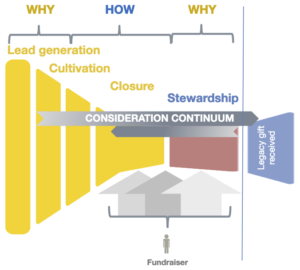
Then, once the giving decision has finally been made and action has been taken by the donor (and the gift gets closed), they’ll likely go right back to seeking why messages. They’ll wonder, “Why should I give again? Why should I keep your organization in my estate plan? or Why should I make another legacy gift using other methods with additional assets?”
Why messages that might support them in this stage could revolve around:
- Reporting what you did or will do with the money;
- Reminding the donor how she achieved or will achieve her goals;
- Helping her further realize the best version of herself;
- Helping her continue to self-actualize;
- Helping her contemplate the fact that she might be able to live on after her lifetime in the minds of others;
- Helping her gain even more notoriety;
- Helping her enjoy being part of a community;
- And so on.
After she receives the why messages (stewardship messages), she will be more likely to move herself to consider a new set of how messages. Then, if you are doing this well and you are focusing on your high-capacity donors’ needs instead of your own, the cycle will continue over and over again and you’ll shore up your organization’s finances.
Let’s wrap this up!
The bottom line here is that for too long, too many in the sector have gotten it wrong. They’ve told other fundraisers, leaders and board members to focus on low-dollar, impulse oriented communications. They’ve told them to focus on volume (spray and pray) while ignoring their leaky bucket (retention). And, they’ve told them to focus on how messages (that miss the mark because their timing is off) instead of why messages.
If you care about your donors, it is essential that you step out of your own shoes and your office. You simply must work toward seeing things from your donors’ perspectives. Then, you must create communications that align with where they reside in the consideration process (mostly using why messages). After that, you need to monitor their engagement with those messages so you can be there to conveniently help facilitate your donors’ movement forward in the consideration process. That’s when you and your donor will benefit from your how messages at that time, not before.
Am I making sense? Let me know what you think.

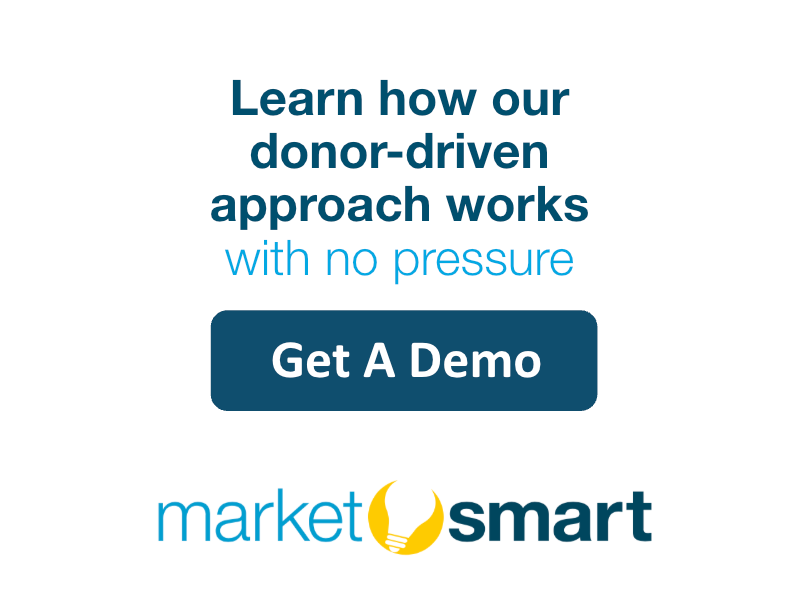
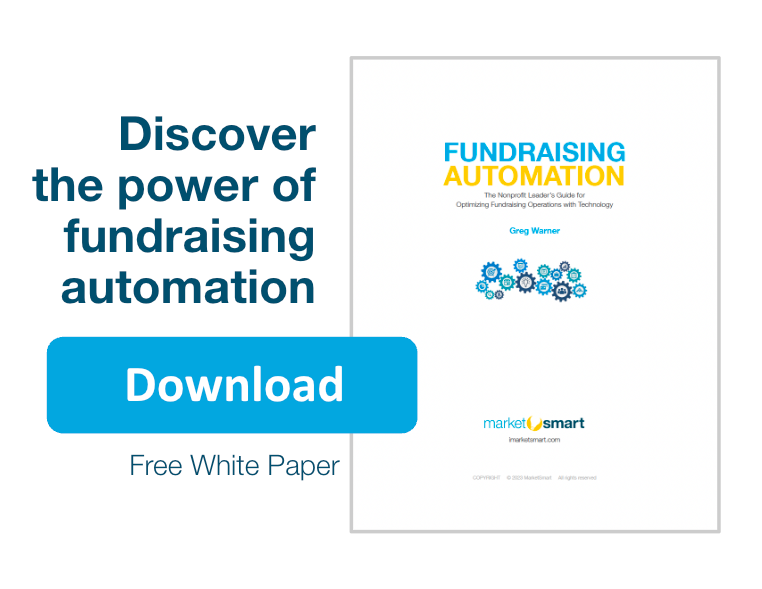
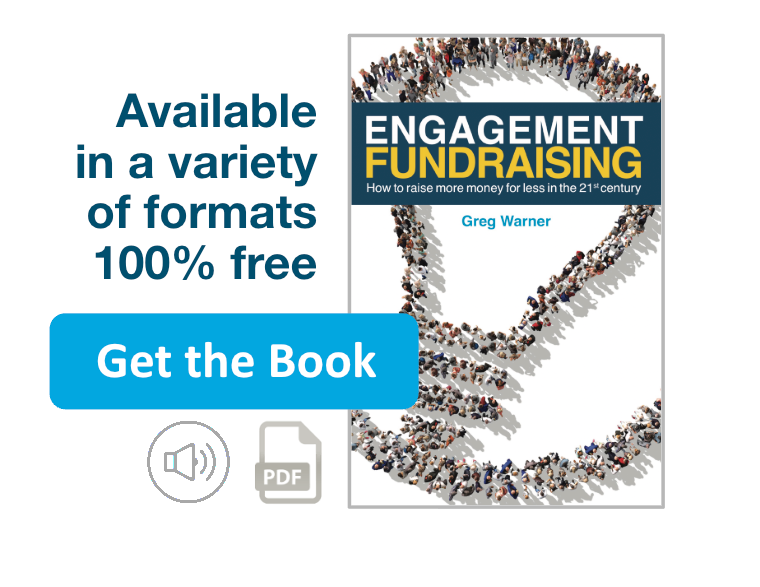

Great thought leadership! Would like to stay in touch. Best wishes, Karen Feinberg
Thanks Karen!!
Excellent article! I so often see the “How” messaging from nonprofits. As with all interpersonal communication, we should remain focused on seeing things from another’s perspective. As you so well explained, this is critical to a successful fundraising program. And much more rewarding for the fundraiser, too, I might add!
Indeed Karen, this helps folks like you ‘be the fundraisers they always wanted to be!’
Your insights are always spot on. Just got your book and am starting to read . Thanks for your wisdom. Do you do speaking engagements? Let me know.
Bill Winkler
winklerbill7@gmail.com
Thanks so much Bill. Hope you like the book!!
I rarely do live speaking engagements but I am happy to do webinars if you’d like. Here’s one that people really enjoy! https://www.youtube.com/watch?v=MOmczu9eTGQ&feature=youtu.be
Yes, you are making sense Greg!
Understanding the process is important if you’re a fundraiser, of course. But as you suggest, it’s only one side of the equation. The flip side, equally important, is the donor’s process.
Please, folks: Read and heed! Don’t ask for a gift before it’s time. You do yourself, and your donor, a disservice.
Thanks so much. When Claire Axelrad says I’m making sense, I know it’s true! Much appreciated!!
Greg.
Spot on! There is a big difference between transactional fundraising and relationship fundraising. And with the Internet and a new “buyer” paradigm, one must understand all the facts as you laid out. Being “client-donor” centered was important 20+ years ago when I started in major gifts and planned giving, and it is even more important today.
Thanks Don. I’m happy to hear you liked the post!
This is very helpful–thank you! You hit it on the mark–especially for a mid-small non-profit with little experience reaching out to bigger donors to help them with the WHY questions. That is something we have trouble with and can relate to. Can you give examples of best practices or specific language you might use (techniques) for hitting those two WHY points:
“Help them realize the best version of themselves?”
“Help them self-actualize?”
What does a statement that supports Self Actualization look like?
Hi Siri. Simply helping people reflect on their lives is a good way to start. For instance, asking them why they care, who inspired them to care, when they first began to care, etc. Then, you’d want to ask them about their goals… what change do they want see in the world. Where do they think change needs to happen, etc.
Basically through questions, you can help them think about their lives and what’s important to them. Then you’ll want to see if their goals align with your organization’s mission. If they do, and there’s a fit, it will become natural for them to support your cause to realize the best versions of themselves and self-actualize.
Hope that helps!
Thank you Greg for this wonderful advice. Being a relative “newbie” to the fundraising for the non-profit sector, your informative article was filled with some great and very applicable content. I have years of experience in raising capital for both established, and start up companies; and while there are many parallels, there are obviously many differences. The “HOW” concept that you wrote about seems so simple, but I’m willing to bet that it will inevitably fall upon deaf ears to many who are trying to raise dollars for their respective organizations. THESE ears have heard you loud and clear. I have recently begun making visits and calls to the people I believe can become legacy donors, and I am very glad that I read your blog post. What you have written has helped me to conclude that the process that I am using is the direction I should be headed. I have started by “planting seeds” and simply letting these business owners and individuals know that I am now affiliated with this organization. Already, I have had a couple contact me to find out more about us and our various programs. Each one has been happily surprised to find out that programs that they support and believe in are actually delivered to our community via the organization that I work for. As you stated, this is not a process that can be rushed. I am thankful for your helpful information, and I look forward to putting it into practice everyday, with each relationship I continue to foster. GOD Bless you!
Thanks for reading my blog David! Much appreciated!!
Thank you for this piece of information! I find it very helpful to understand the stage of donors. My background is marketing and I believe understanding the behaviors of donors is vital. This helps with my research for my front line fundraisers. I also look forward to the Benchmark Study that MarketSmart put together for 2020! It is so important to have data behind how donations are being circulated as we all competing for donors. Thank you for your efforts in putting together this study and look forward to reviewing it soon!
Greg,
This is a great piece..and thank you for posting it. I worked with very affluent clients for 40 years and I know how they think and I actually helped them form their consideration process, especially with clients who came into wealth suddenly instead of earning it. Those who earned it made it by being very good businessmen/women and they did not make quick decisions in their business, so why would they do it regarding a gift. Wealthy people want to maintain a level of wealth and want to be knowledable about the non profit, their finances, their management, their history, their fundraising costs, to name just a few. They also have to have a passion for the work of the organization. Just because they have money does not mean that they are just going to give it away. It takes time, patience, and get to know them as people, not as a checkbook. They are real people with real lives and challenges as well. I have been so honored to work with so many wonderful families over the years and have been blessed to be able to get to know them.
Thank you Diane. You made my Monday!! 🙂
Thanks so much for putting into words what I guess I’ve known instinctively. Thinking about it now, when sitting in my office contemplating where the next gifts are going to come from, my mind wanders directly to the more transactional aspects of giving. But when I’m out of the office talking with prospective donors, I naturally engage on the motivational “why” aspects of giving and focus more on what a gift will mean for them than what it will mean to our organization. Looking at the larger gifts I’ve helped facilitate over the years, the process nearly always wound up focusing on the donor’s desires more so than the needs of the organization. In those instances, I’ve even found myself back in the office explaining to a President or a CEO why we should go in the direction the donor is leaning toward, rather than trying to force the donor’s “square peg” interests into our “round hole” mold of needs.
Excellent Dennis. Sounds like you’re ‘doing it right!’
Thanks for your refreshing insight Greg! Anything to add for donor advised public foundations? There is no fundraising – no specific cause to support, the client’s generosity plan is deliberate, time sensitive (weeks, months, years), relational vs transactional and very often includes support from their professional advisors.
[…] As marketers know, creating target audience personas can be immensely helpful for crafting compelling narratives and calls-to-action. The same goes for understanding prospective donors. […]
[…] As marketers know, creating target audience personas can be immensely helpful for crafting compelling narratives and calls-to-action. The same goes for understanding prospective donors. […]